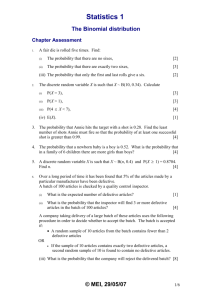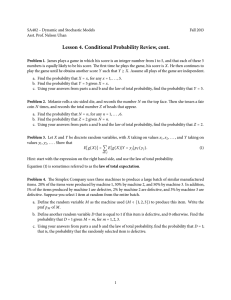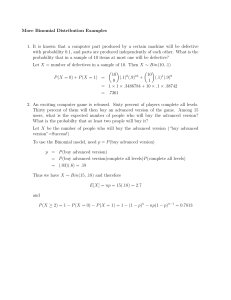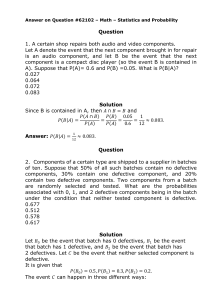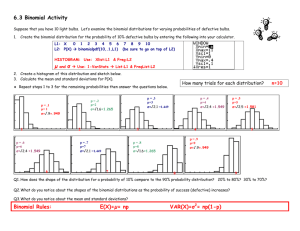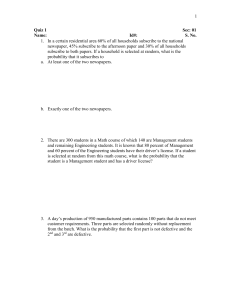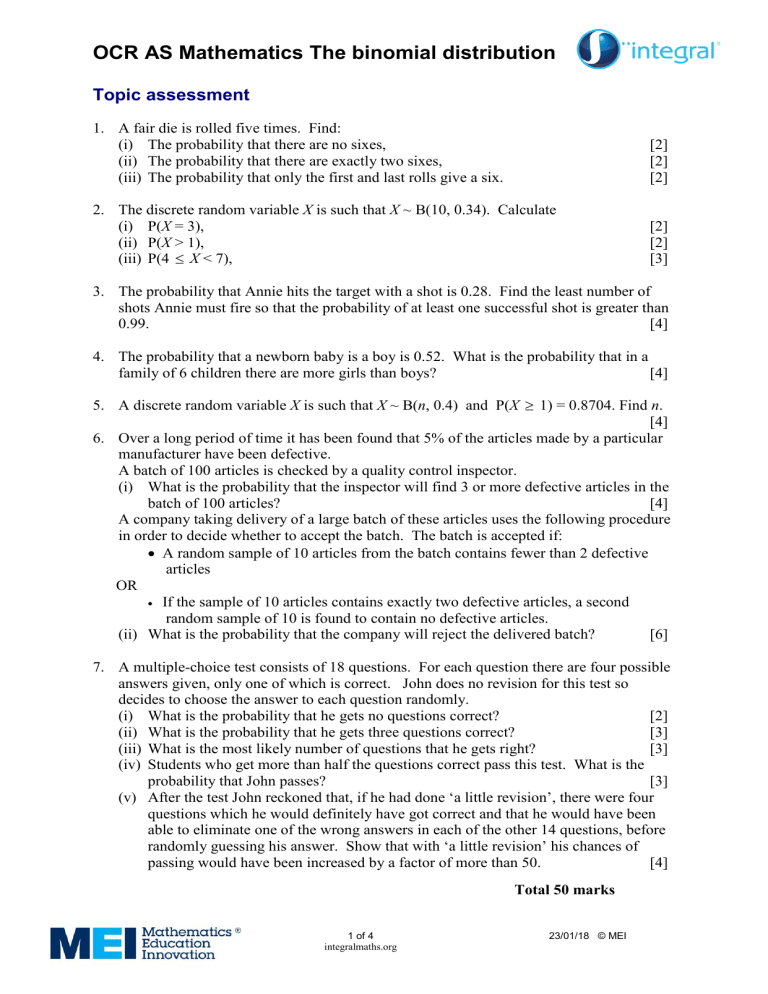
OCR AS Mathematics The binomial distribution Topic assessment 1. A fair die is rolled five times. Find: (i) The probability that there are no sixes, (ii) The probability that there are exactly two sixes, (iii) The probability that only the first and last rolls give a six. [2] [2] [2] 2. The discrete random variable X is such that X ~ B(10, 0.34). Calculate (i) P(X = 3), (ii) P(X > 1), (iii) P(4 X < 7), [2] [2] [3] 3. The probability that Annie hits the target with a shot is 0.28. Find the least number of shots Annie must fire so that the probability of at least one successful shot is greater than 0.99. [4] 4. The probability that a newborn baby is a boy is 0.52. What is the probability that in a family of 6 children there are more girls than boys? [4] 5. A discrete random variable X is such that X ~ B(n, 0.4) and P(X 1) = 0.8704. Find n. [4] 6. Over a long period of time it has been found that 5% of the articles made by a particular manufacturer have been defective. A batch of 100 articles is checked by a quality control inspector. (i) What is the probability that the inspector will find 3 or more defective articles in the batch of 100 articles? [4] A company taking delivery of a large batch of these articles uses the following procedure in order to decide whether to accept the batch. The batch is accepted if: A random sample of 10 articles from the batch contains fewer than 2 defective articles OR If the sample of 10 articles contains exactly two defective articles, a second random sample of 10 is found to contain no defective articles. (ii) What is the probability that the company will reject the delivered batch? [6] 7. A multiple-choice test consists of 18 questions. For each question there are four possible answers given, only one of which is correct. John does no revision for this test so decides to choose the answer to each question randomly. (i) What is the probability that he gets no questions correct? [2] (ii) What is the probability that he gets three questions correct? [3] (iii) What is the most likely number of questions that he gets right? [3] (iv) Students who get more than half the questions correct pass this test. What is the probability that John passes? [3] (v) After the test John reckoned that, if he had done ‘a little revision’, there were four questions which he would definitely have got correct and that he would have been able to eliminate one of the wrong answers in each of the other 14 questions, before randomly guessing his answer. Show that with ‘a little revision’ his chances of passing would have been increased by a factor of more than 50. [4] Total 50 marks 1 of 4 integralmaths.org 23/01/18 © MEI OCR AS Maths Binomial Assessment solutions Solutions to topic assessment 1. Let X be the number of sixes obtained X ~ B(5, 61 ) 5 5 3125 (i) P(X = 0) 0.402 (3 s.f.) 7776 6 [2] 2 3 1 5 5 4 1 125 625 (ii) P(X = 2) 5 C 2 0.161 (3 s.f.) 1 2 36 216 3888 6 6 [2] 1 5 5 5 1 125 (iii) Probability 0.0161 (3 s.f.) 6 6 6 6 6 7776 [2] 2. X ~ B(10, 0.34) C 3 0.34 0.66 10 9 8 0.34 3 0.66 7 123 0.257 (3 s.f.) (i) P(X = 3) 3 7 10 [2] (ii) P(X > 1) 1 P( X 1) 1 0.096 0.904 (3 s.f.) [2] (iii) P(4 X < 7) P( X 6) P( X 3) 0.9780 0.5411 0.437 (3 s.f.) [3] 3. Let X be the number of successful shots. X ~ B(n, 0.28) P( X 1) 0.99 1 P( X 0) 0.99 P( X 0) 0.01 (0.72)n 0.01 0.72 14 0.0101 and 0.72 15 0.00724 So the least number of shots is 15. [4] 4. Let X be the number of boys X ~ B(6, 0.52) There are more girls than boys if X = 0, 1 or 2. 2 of 4 integralmaths.org 23/01/18 © MEI OCR AS Maths Binomial Assessment solutions Probability P( X 2) 0.307 (3 s.f.) [4] 5. X ~ B(n, 0.4) P ( X 1) 0.8704 1 P( X 0) 0.8704 P( X 0) 0.1296 0.6n 0.1296 n 4 [4] 6. X ~ B(100, 0.05) (i) P(X ≥ 3) 1 P( X 2) 1 0.118 0.882 (3 s.f.) [4] (ii) Let Y be the number of defective articles in a sample of 10 Y ~ B(10, 0.05) P(Y = 0) 0.95 10 P(Y = 1) 10 0.05 0.95 9 10 9 0.05 2 0.95 8 45 0.05 2 0.95 8 P(Y = 2) 12 P(fewer than 2 defective articles) 0.95 10 10 0.05 0.95 9 0.91386 P(2 defective articles in 1st sample; no defective articles in second sample) 45 0.05 2 0.95 8 0.95 10 0.04469 P(rejecting batch) 1 0.91386 0.04469 0.0415 (3 s.f.) [8] 7. Let X be the number of questions John gets correct. X ~ B(18, 0.25) (i) P(X = 0) 0.75 18 0.00564 [2] (ii) P(X = 3) 18 C 3(0.25 )3(0.75 )15 18 17 16 (0.25 )3(0.75 )15 123 0.170 (3 s.f.) [3] 3 of 4 integralmaths.org 23/01/18 © MEI OCR AS Maths Binomial Assessment solutions 18 17 16 (0.25 )3(0.75 )15 0.202 123 18 17 16 15 (0.25 )4(0.75 )14 0.213 P(X = 4) 12 34 18 17 16 15 14 (0.25 )5 (0.75 )13 0.199 P(X = 5) 1 2 3 4 5 The most likely outcome is that he will get 4 questions right. (iii) P(X = 3) [3] (iv) P(passing) P( X 9) 1 P( X 9) 1 0.99458 0.00542 (3 s.f.) [3] (v) For the other 14 questions, let Y be the number of right answers. Y ~ B(14, 31 ) To pass, at least 6 of these 14 questions must be correct. P(Y 6) 1 P(Y 5 ) 1 0.68981 0.31019 0.31019 57.2 0.00542 so chances of passing have been increased by a factor of more than 50. [4] 4 of 4 integralmaths.org 23/01/18 © MEI
